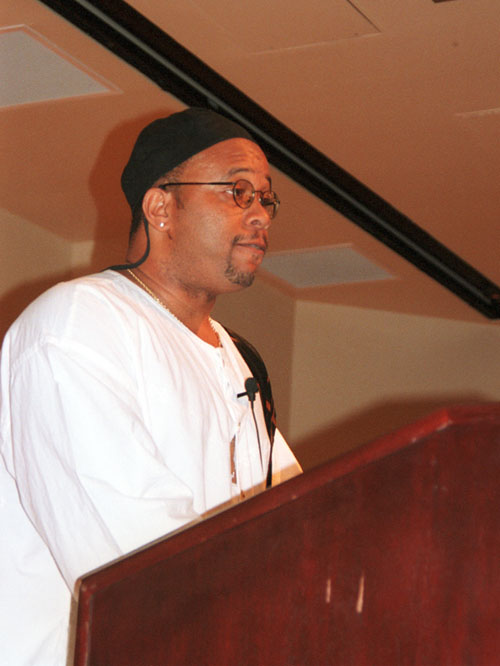Symposium examines diversity and tolerance
Image: Symposium examines diversity and tolerance:William Parker conducts a presentation on African-American theater Friday at the Sacramento State Writers and Thinkers Symposium. The two day event was held in the University Union. (Photo by Casey McCracken/State Hornet):
May 8, 2001
The third Sacramento State Writers and Thinkers Symposium took place over a two-day period last week in the University Union. The symposium, which began at 9 a.m. Thursday morning and lasted through Friday evening, is part of the university?s Year of Unity and revives a tradition of similar events held on campus in the late 1970s.
This year?s theme was, “The discourse of Tolerance, Difference and ?Other?: Examining the Sign called Unity,” coinciding with the Year of Unity. Its purpose was to foster the idea of understanding diversity beyond the traditional borders of art and academics.
The festivities began with opening comments from President Donald Gerth, who emphasized the importance of the Year of Unity and how the symposium is a step toward a better tolerance of others.
“Hate-driven incidents, on and off-campus, started the Year of Unity. This symposium will demonstrate to the community and region that we are concerned and are taking steps toward tolerance,” Gerth said.
Gerth also credited the Year of Unity for being a success, with activities that have gone beyond his expectations.
Keynote speakers at the symposium included Juan Bruce-Navao, Ph.D., professor at UC Irvine, and William Wong, author of “Yellow Journalist: Dispatches from Asian America.” There were also panel discussions with guest speakers and Sac State professors and students as moderators, each focusing on the importance of a multicultural societyThe host of the symposium was Olivia Castellano, a Sac State English professor who was involved in all three symposiums.
Castellano found the theme of the symposium to be ambitious, “one which will bring about dialogue and exchange that are at the core of the Year of Unity.”
She said the symposium was exciting.
“It?s a part of an entire multicultural art and thought. And this is an attempt to bridge all that and launch a series of multicultural movements,” Castellano said.
The theme of the symposium was present in the six panel discussions, each focusing on the importance and history of diversity. One of the more popular and well attended discussions was “Hate Crime/Hate Speech,” moderated by Tom Payne, a Sac State professor, which focused on the prejudices and hatred felt toward mankind. There was also a lecture and book signing by Wong.
Although the size of the audience was relatively small, most of the participants and attendees shared the common feeling of appreciation of having such a symposium to educate the people.
There were about 35 people present for the introduction and the first lecture on Thursday, and about 25 people on Friday afternoon?following the same pattern in the number of audience members throughout the event.
Attendees included Sac State professors, students and community members. The reaction of those who attended was very positive.
“You can?t look in terms of turnout, look in terms of presence; at least it?s here,” said Maria Fernandez, a student and moderator of panel discussions.
Castellano agreed that, although the turnout was not as large as expected, it planted an idea of an ongoing effort of coming together.
Fracing Edralin, a Sac State English major, attended five events over the two days and was interested in the diversity on campus, yet she was also upset that more students hadn?t shown up.
Another Sac State student and participant, Kathy Shea, was disappointed that more students couldn?t have had the pleasure of attending.
“We need more of this, it would be helpful to the university and students,” Shea said.
Even Gerth emphasized quality over quantity when it came to the turnout of the events.
“Life of the university is not a matter of bringing together 50 percent plus one of the campus, instead generating ideas and permitting these ideas to grow,” Gerth said.





























































































































